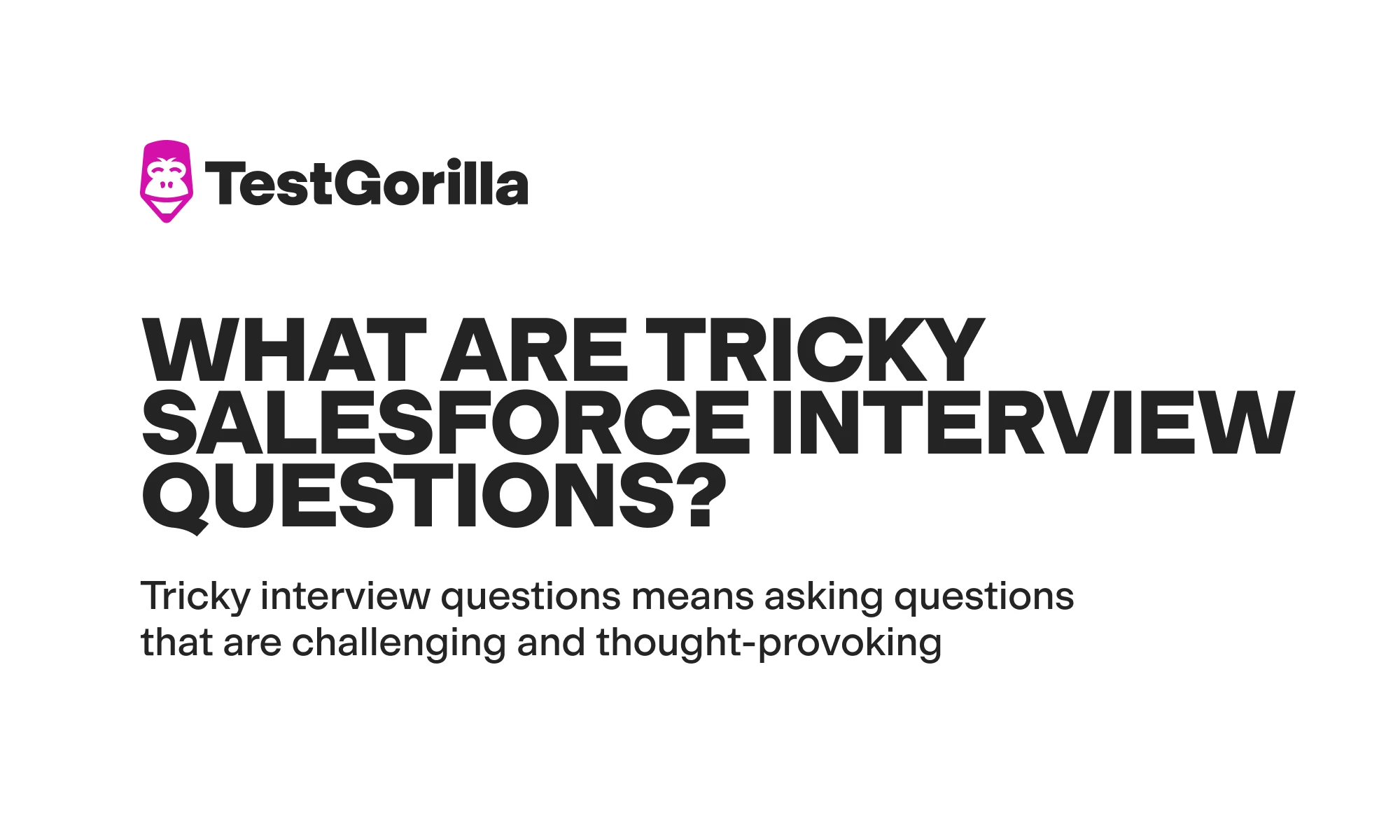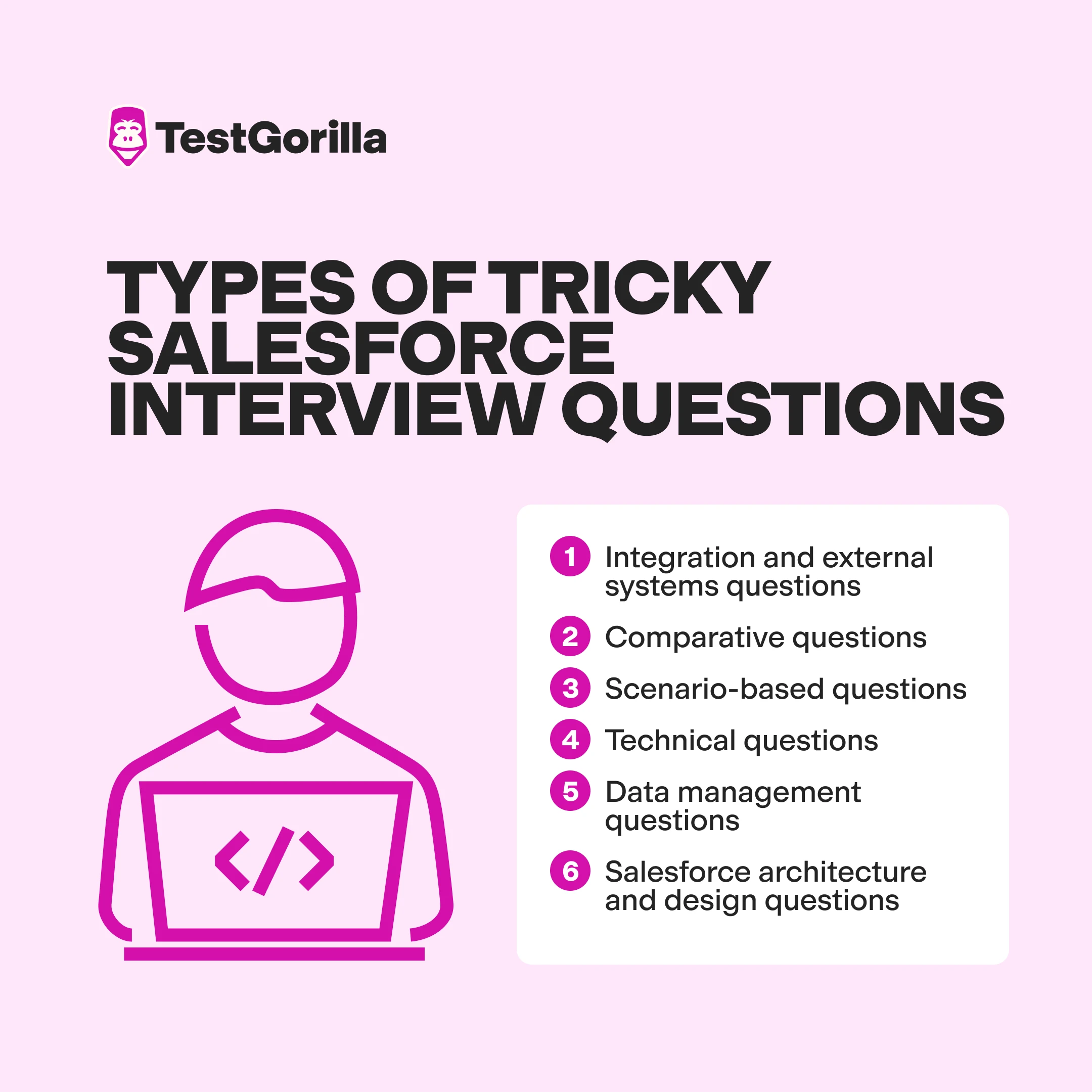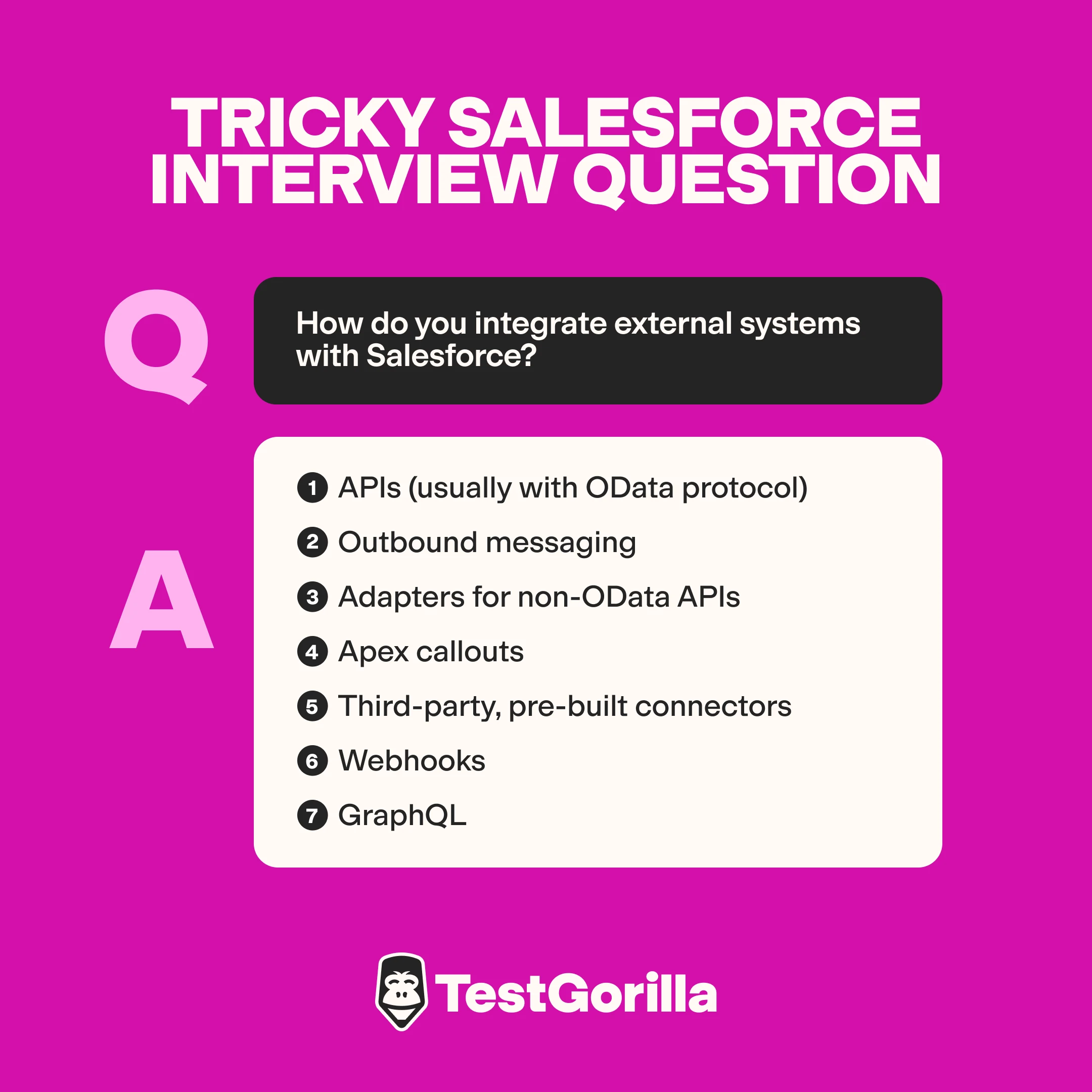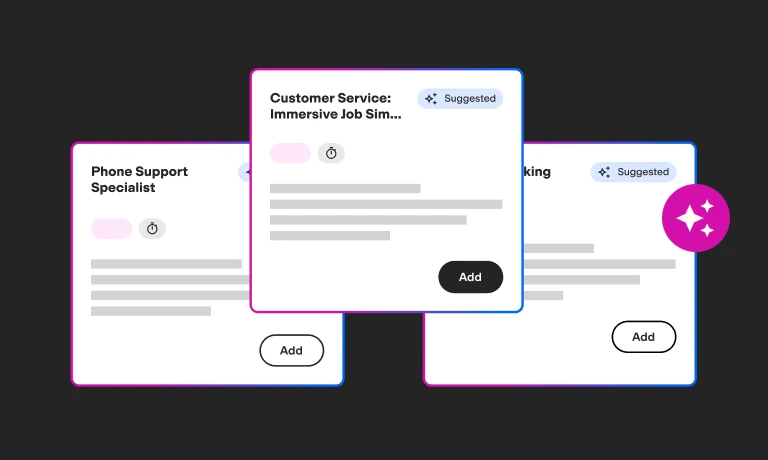32 tricky Salesforce interview questions to include in your hiring campaign (with top answers)
Salesforce powers businesses by managing sales, marketing, and customer data – but only if you have the right talent to operate its software effectively. Hiring the best means avoiding poor configurations and weak security that can derail customer trust.
To avoid this, we’ve put together this Salesforce interview questions guide. It’ll arm you with 32 smart Salesforce questions to pinpoint candidates who truly know their stuff and can take your business to the next level. You’ll also learn how to identify the best answers when evaluating your top picks.
Table of contents
- Key takeaways
- What are tricky Salesforce interview questions?
- Top 3 reasons to include tricky Salesforce interview questions in your hiring campaign
- 32 tricky Salesforce interview questions and answers
- How to add tricky Salesforce interview questions to your hiring campaign
- Identify top Salesforce talent with TestGorilla
- FAQs
Key takeaways
Salesforce is essential for many businesses, but hiring the right talent is critical to unlock its full potential.
Use tougher Salesforce interview questions to assess technical expertise within the Salesforce platform and its integrations, as well as crucial soft skills like problem-solving and adaptability.
Tricky Salesforce interview questions – combined with skills-based hiring – help eliminate hiring bias and ensure you’re hiring as smartly as possible.
TestGorilla’s skills-based assessments enable you to efficiently and effortlessly evaluate Salesforce candidates.
What are tricky Salesforce interview questions?
When we discuss “tricky” interview questions, we don’t mean being deceptive, but instead, asking questions that are challenging and thought-provoking.
These tricky questions go beyond the basics and enable you to assess a candidate’s problem-solving skills and technical knowledge carefully. Complex, scenario-based Salesforce interview questions help star candidates stand out and showcase their ability to handle demanding situations.
There are several types of tricky Salesforce interview questions, each focusing on different aspects of a candidate's capabilities. These include:
1. Integration and external systems questions
These focus on candidates' understanding of integrating Salesforce with external systems using application programming interfaces (APIs). You can ask candidates to describe considerations, challenges, and best practices for seamless integration.
2. Comparative questions
Answering these questions, candidates will compare and contrast different Salesforce features, functions, or development approaches. For example, candidates may need to explain the differences between master-detail and lookup relationships.
3. Scenario-based questions
These provide candidates with hypothetical situations or challenges that Salesforce professionals often encounter. Candidates must provide effective solutions and explain their thought processes to demonstrate their ability to handle complex scenarios.
4. Technical questions
Technical Salesforce questions delve into Salesforce concepts, features, and best practices. For instance, they can assess candidates’ understanding of Visualforce, Apex code, Salesforce Object Query Language (SOQL), and governor limits.
5. Data management questions
These questions assess candidates' abilities to handle data in Salesforce, such as data deduplication, import and export, migration, quality, and validation rules.
6. Salesforce architecture and design questions
Tricky questions in this category explore candidates' understanding of Salesforce architecture, custom objects, custom settings, and designing scalable solutions.
The best insights on HR and recruitment, delivered to your inbox.
Biweekly updates. No spam. Unsubscribe any time.
Top 3 reasons to include tricky Salesforce interview questions in your hiring campaign
Making tricky Salesforce interview questions front and center of your hiring campaigns can help you evaluate candidates’:
1. Technical proficiency
Complex Salesforce questions enable you to measure candidates’ technical expertise. By presenting tricky scenarios and asking for in-depth explanations of Salesforce features, you can identify candidates with a deep understanding of the platform's capabilities and limitations.
This way, you can easily separate your most knowledgeable applicants from the rest of your candidate pool and advance them to the next stage of recruitment.
2. Problem-solving abilities and adaptability
Tricky questions assess applicants’ problem-solving skills under pressure. They enable you to see how they approach unfamiliar problems, analyze information, and create innovative solutions – all critical skills in a dynamic Salesforce environment.
These questions also allow applicants to showcase their ability to adapt and thrive in challenging situations. They can share examples of when they’ve used quick thinking and flexibility to navigate the ever-changing Salesforce landscape.
3. Hire-readiness
Asking tricky interview questions gives you a comprehensive view of your Salesforce candidates’ skills. By combining these questions with other pre-employment assessments, like personality and job-specific tests, you can make better hiring decisions overall.
In turn, you’ll create a stronger, more skilled Salesforce team that can tackle complex projects, find innovative solutions, and drive continuous improvement.
32 tricky Salesforce interview questions and answers
Ask your applicants the following 32 complex Salesforce questions to discover top talent. We also provide sample answers for each question.
1. Explain the differences between a role and a profile in Salesforce.
A profile is a set of permissions and settings that determine what a user can do within Salesforce. Often, profiles are tied to departments, such as Sales or Support groups.
Roles, on the other hand, determine what a user can see and access within Salesforce. Roles are more closely linked to hierarchy within an organization.
2. What are governor limits in Salesforce, how can you overcome them, and how does asynchronous processing help?
Governor limits are runtime limits that Salesforce enforces to ensure system efficiency, such as limits on the number of SOQL queries or DML statements per transaction. To overcome these, you can optimize code by bulkifying queries, using efficient indexing, and caching data where possible.
Asynchronous processing, such as Queueable Apex or Batch Apex, helps by executing tasks in separate transactions, allowing more governor limits to apply independently. This approach is useful for handling large data volumes or long-running processes without hitting limits.
3. Can you describe how record-level security is enforced in Salesforce?
Record-level security refers to the records in each object a user can view or edit that are accessible in their profile. Firstly, the organization-wide defaults set the baseline access for different objects, determining whether they are publicly readable or writable.
Then, there is role hierarchy, which extends access to higher-level roles, allowing them to view records owned by users below them in the hierarchy. Additionally, sharing rules can be set up to grant access based on specific criteria, and manual sharing enables users to share individual records with others on a case-by-case basis.
4. How is the “with sharing” keyword used in Apex within Salesforce?
The “with sharing” keyword is used to enforce record-level security on a class and extend sharing access on a particular object. When a class is declared with the “with sharing” keyword, it ensures that the sharing rules and organization-wide defaults defined in Salesforce are applied to the data accessed within that class.
This means that the class will respect the record-level access permissions of the current user, and users will only be able to access records for which they have the appropriate permissions based on their role, profile, and sharing settings.
5. How do you handle bulkification in Apex triggers to avoid hitting governor limits?
Make sure to process records in bulk rather than individually. Instead of querying and updating records individually, use collections and SOQL queries – as long as they’re not within the FOR loop – to handle multiple records simultaneously. This way, you can reduce the number of database queries and DML operations, which helps stay within the governor limits.
Additionally, use helper methods to perform complex logic and avoid repeating code, ensuring streamlined execution and minimizing resource consumption.
6. How do you implement and optimize Salesforce Flows for business automation?
Salesforce Flows are implemented by creating visual workflows that define steps and conditions for automating processes.
To optimize Flows:
Use sub-flows to break down complex processes into manageable components.
Leverage fault paths to handle errors gracefully.
Avoid unnecessary loops and conditions that may impact performance.
Regularly test and debug Flows using the Flow Debugger.
Monitor Flow performance in the setup’s Flow Usage Metrics to identify bottlenecks.
Flows simplify automation by reducing dependency on Apex code while providing powerful, scalable solutions.
7. How can you implement one-to-many relationships in Salesforce?
You can use the lookup and master-detail fields to create one-to-many relationships in Salesforce. These fields help connect records from one object to records in another object.
With a lookup field, you can link one record from the first object to one record in the second object. Meanwhile, a master-detail field connects multiple records in the second object to one record in the first object.
8. What are the various types of sandboxes and Scratch Orgs in Salesforce, and when would you use each for development and deployment?
Salesforce provides several sandbox types:
The Developer sandbox is for individual developers to test and develop features.
The Developer Pro sandbox is similar to Developer but has more storage for larger projects.
A Partial Copy sandbox contains a subset of production data to test specific use cases.
A Full sandbox is a full replication of production for end-to-end testing.
Scratch Orgs are temporary and designed for source-driven development, which is ideal for CI/CD pipelines and version control systems. They’re commonly used to test new features in isolation before merging into production.
9. How do you handle exceptions and errors in Apex code?
In Apex code, exceptions and errors are handled to prevent the program from crashing and to give users a better experience.
When something unexpected happens, try-catch blocks are used to catch and handle the error gracefully. This works by enclosing code with an exception in a try block, which is then enclosed in a catch block if the try block itself shows an exception. Instead of showing a clunky error message, it can display a friendly message to users or log the issue for developers to fix.
10. What are custom metadata types, and how do they improve configuration management in Salesforce?
Custom metadata types are objects used to define application configurations that can be packaged and deployed across orgs.
Unlike custom settings, metadata types support version control and are ideal for managing reusable, declarative configurations. For example, they can store API endpoint URLs or thresholds for automated processes.
They improve configuration management by enabling admins to make adjustments declaratively without altering code, ensuring consistency across environments during deployment.
11. What is the role of the Schema Builder in Salesforce?
The Schema Builder in Salesforce is a graphical tool that allows developers to view and manage the objects and relationships in their Salesforce org. It provides a visual representation of the data model, making it easier to understand and modify the schema.
12. How do you handle data imports and exports in Salesforce?
Data Import Wizard and Data Loader are used to import data from spreadsheets or other sources into Salesforce.
For exports, tools such as Data Export and Data Export Service are used to get data out of Salesforce and save it as files. It's like making a copy of the information for use outside of Salesforce.
Handling data imports and exports helps keep the information up-to-date and lets users work with data from different places easily.
13. How can you perform a mass update of records in Salesforce?
One way to do this is using the Data Loader tool, where you can upload a spreadsheet with the updated information and match it to the right records in Salesforce. The tool will then apply the changes to all the matched records in one go, saving time and effort.
Another method is using the Salesforce Reports and Dashboards feature. You can create a report to filter and find the records you want to update, then use the Mass Edit option to change multiple records simultaneously.
You can also set up a custom list view. To do this, you’ll first need to enable special permissions on the profile user interface, including the Mass edit from lists, Inline editing, and Enhanced lists options.
From there, you can create a list view and specify different record types and visibilities. Once you’ve set up the list view, click the bulk edit checkbox at the top to select all the records. Any changes you make will update the entire list.
14. How can you optimize SOQL queries to improve performance?
To optimize SOQL queries in Salesforce, you can:
Ensure your queries are selective and filtered on indexed fields
Avoid querying large numbers of records in a single query
Use aggregate functions like sum, count, and avg to avoid unnecessary fields
Use relationship queries (joins)
Use custom index functions
Use limit clauses
Bulkify queries in Apex
Avoid nested queries
Cache data where possible
Monitor query performance
15. How would you decide between using a trigger and a Flow in Salesforce for automation?
The choice depends on the complexity of the process and the need for customization.
Use Flows for declarative, point-and-click automation such as field updates, sending notifications, or simple logic. Flows are easier to maintain and require no coding expertise.
Use Apex triggers for complex, programmatic tasks like handling multiple objects simultaneously, managing large data volumes, or invoking third-party APIs.
For maintainability, prioritize Flows whenever possible unless the business logic necessitates Apex.
16. What is a roll-up summary field, and how is it used in Salesforce?
A roll-up summary field calculates values from related records and displays a summary of the results on the parent record. It's commonly used to perform calculations like sum, count, average, maximum, or minimum on child records and display the result on the parent record.
17. What is the use of the @future annotation in Apex?
The @future annotation identifies and executes a method asynchronously in Apex. When a method is annotated with @future, it runs in a separate thread, independent of the current transaction. This allows the method to be called and executed later rather than immediately within the current context.
The main purpose of using the @future annotation is to offload time-consuming or resource-intensive tasks from the main transaction, making the application more efficient and responsive. It’s commonly used for tasks like sending email notifications, performing callouts to external systems, or processing large volumes of data.
18. How do you integrate external systems with Salesforce, and what role do MuleSoft, Pub/Sub APIs, or GraphQL play in modern integrations?
Integrating external systems with Salesforce ensures seamless data flow and communication. Here’s how this works:
APIs (usually with OData protocol): APIs allow data exchange and real-time communication between Salesforce and external applications.
REST: Best for lightweight integrations like fetching or updating records via HTTP methods (GET, POST, and PUT). Use tools like Postman to test API requests and implement authentication via OAuth.
Bulk: Ideal for handling large data volumes, such as migrating datasets between systems. Bulk API 2.0 simplifies asynchronous processing for data import/export.
Pub/Sub: Facilitates real-time event-driven communication by publishing changes in Salesforce to subscribed external systems (like notifying a third-party inventory system about a sales update).
SOAP: A robust option for legacy systems, particularly when schema validation or complex operations are required. Use WSDL (Web Services Description Language) files to define integration points.
Outbound messaging: Used in Workflow Rules or Flows to send notifications (XML-based) to external systems when a record is created or updated. Configure endpoints in Salesforce for automatic transmission of data.
Adapters for non-OData APIs – including middleware tools like MuleSoft and custom adapters – enable integrations with systems that don’t natively support OData protocols. For example, MuleSoft’s Anypoint platform can transform non-OData data structures into formats compatible with Salesforce APIs.
Apex callouts allow custom integrations by sending HTTP requests to external services. Use “HttpRequest” and “HttpResponse” classes in Apex to handle API requests and responses securely. Ensure callouts are wrapped in @future methods or Queueable Apex to comply with governor limits.
Third-party, pre-built connectors – like MuleSoft’s Salesforce Connector – simplify integration with popular platforms, such as SAP or NetSuite. These tools minimize coding by providing drag-and-drop interfaces for mapping data between Salesforce and other systems.
Webhooks enable external applications to listen for changes in Salesforce records. For instance, you can set up a webhook to trigger an HTTP POST request when an opportunity is closed, notifying your accounting system to generate an invoice.
GraphQL – a query language for APIs and a runtime for fulfilling queries with existing data – provides a flexible approach to data retrieval, offering efficient and precise data fetching.
GraphQL provides a flexible query-based approach to data retrieval, offering efficient and precise data fetching.
19. Can you explain the differences between a lookup relationship and a master-detail relationship in Salesforce?
A lookup relationship creates a link between two objects, allowing users to link records from one object to another. A master-detail relationship creates a parent-child relationship, where the child record inherits certain behaviors and permissions from the parent.
20. How do you handle data migration from one Salesforce org to another?
Data migration from one Salesforce org to another can be done using the Data Loader, Change Data Capture, or Salesforce Data Integration tools. It involves extracting data from the source org, transforming it as needed, and loading it into the target org.
21. How do you handle data deduplication in Salesforce?
Data deduplication in Salesforce involves identifying and removing duplicate records to maintain data accuracy and integrity. To achieve this, you can use tools like Data Import Wizard, Data Loader, or third-party deduplication apps.
22. How do you implement validation rules to enforce data quality in Salesforce?
To implement validation rules in Salesforce and enforce data quality, go to the Object's settings, navigate to the Validation Rules section, and create rules with specific criteria and error messages. These rules will be triggered when users attempt to save records, ensuring that data adheres to the defined criteria and maintains its accuracy and consistency.
23. Describe how you can maintain data privacy and security in Salesforce.
You can establish strong user authentication measures, such as through Salesforce’s multi-factor authentication options or by connecting the platform with outside authentication apps like OKTA for added security. You can also define user profiles and roles to control data access and encrypt sensitive data at rest and in transit.
Additionally, you can regularly monitor user access and usage patterns, conduct security audits, and provide ongoing training to ensure users follow best security practices.
On top of that, Salesforce enables you to export org data in CSV files. This serves as a backup of your information in the event of a security breach or data loss.
24. Can you explain the differences between static and dynamic SOQL queries in Apex?
In Apex, static SOQL queries are written at compile-time and are fixed, meaning the query structure and fields are known before execution. These are written within square brackets.
Dynamic SOQL queries, on the other hand, are constructed at runtime as strings and allow for building queries based on dynamic conditions or variables, offering more flexibility in handling varying query requirements.
25. How do you handle long-running processes in Salesforce?
Use Asynchronous Apex, such as Batch Apex or Queueable Apex. This breaks down the process into smaller chunks that can be executed separately and efficiently in the background.
26. Describe what custom labels are used for in Salesforce and when to use them.
Custom labels in Salesforce are used to store text values that can be easily translated into different languages. They provide a way to reference these text values in formulas, Visualforce pages, Apex classes, and Lightning pages and components, allowing for better internationalization and localization of Salesforce applications.
Use custom labels when you need to store static text or messages in a centralized and translatable manner. This provides a more flexible and scalable approach to managing text content. They’re often used for things like help or error messages, as they can be set to appear in various languages, depending on where a user accesses the platform.
27. How do you optimize Visualforce pages for better performance, and what steps would you take to migrate them to Lightning Web Components?
To optimize Visualforce pages, minimize SOQL queries, avoid large datasets, reduce the number of controller actions, and use efficient Apex code. Migrating to Lightning Web Components (LWC) involves analyzing existing Visualforce functionality, identifying reusable components, and redesigning them in LWC for better performance, maintainability, and modern user experience.
28. How would you leverage Salesforce Einstein AI for predictive analytics in sales and marketing?
Salesforce Einstein AI can analyze historical data and identify trends to predict customer behavior, such as lead conversion likelihood or sales forecasting. For marketing, it helps segment audiences and optimize campaigns by predicting which messaging will resonate best with specific groups. Implementing Einstein AI enables businesses to automate insights and make data-driven decisions.
29. Can you explain the benefits and implementation of Salesforce’s Flow Orchestration for automating complex workflows?
Flow Orchestration allows businesses to build multi-step, multi-user workflows within Salesforce. It’s particularly useful for automating approval processes, onboarding new employees, and handling multi-department tasks. It connects various flows, enhances automation, and improves efficiency by reducing manual interventions.
30. What’s your approach to integrating Salesforce with third-party AI tools like ChatGPT for enhanced customer support?
Integration can be achieved using APIs, where Salesforce communicates with tools like ChatGPT for automated responses, knowledge base suggestions, and customer query handling. A robust approach involves ensuring data security, defining integration points (e.g., case management), and monitoring real-time interactions to maintain quality.
31. How do you manage data compliance with Salesforce’s Data Mask feature in a sandbox environment?
Salesforce’s Data Mask allows sensitive data to be obfuscated in sandbox environments, ensuring compliance with data privacy regulations like GDPR or HIPAA. The setup involves defining fields to be masked, applying masking patterns, and periodically auditing masked data to prevent exposure.
32. Explain how Salesforce’s Hyperforce infrastructure impacts global business scalability and security.
Hyperforce redefines Salesforce’s cloud infrastructure by providing localized data storage and enhanced security while allowing rapid scalability. This is critical for global businesses needing to meet regional compliance requirements and maintain performance during periods of high demand.
How to add tricky Salesforce interview questions to your hiring campaign
Tricky Salesforce questions are perfect for evaluating candidates’ technical expertise and problem-solving skills. However, they shouldn’t be the only tool you use during hiring.
To properly assess each Salesforce candidate, use a multi-measure testing technique that pairs challenging questions with skills-based tests, personality assessments, and more.
TestGorilla provides a library of 350+ scientifically backed pre-employment tests, which you can mix and match to create the perfect assessment. For Salesforce roles, in particular, you can use the following:
Salesforce CRM test: Measures skills in managing leads, accounts, and contacts, as well as generating custom reports, tracking and forecasting, integrating with APIs, customizing data and layouts, and much more.
APEX Salesforce test: Helps assess proficiency in Apex fundamentals and design patterns, SOQL/SOSL queries, and the Salesforce data model – as well as identify candidates skilled in Lightning Platform customization.
Salesforce for BDRs test: Evaluates how effectively BDR candidates use Salesforce to contribute to sales team goals and manage workload.
Personality tests (DISC and Enneagram): Offer insights into applicants’ behavioral traits.
Culture Add test: Shows you how well each candidate will mesh with your existing team and company culture.
Soft skills tests: Measure communication, motivation, time management, and more.
TestGorilla also enables you to add custom questions to assessments so you can incorporate your tricky questions directly into tests.
You can also use the one-way video interview tool to have candidates record video answers to your list of Salesforce questions.
By complementing your tricky questions with pre-employment tests, you can ensure you always hire the best talent for your team.
Don’t forget to check out our guide on how to write a Salesforce business analyst job description.
Identify top Salesforce talent with TestGorilla
Hiring an underqualified Salesforce professional can lead to poor customer service, lower efficiency, and even reputational damage. The solution? Thoroughly assess candidates’ Salesforce skills before hiring them.
By asking candidates tricky Salesforce interview questions, you gain a more robust understanding of their technical abilities, problem-solving skills, and adaptability. You can then couple these questions with TestGorilla’s multi-measure assessments to avoid unconscious bias and make data-driven hiring decisions.
With more than “350+” pre-employment tests in our test library, you can evaluate the technical knowledge of a role as well as crucial soft skills – including critical thinking, personality, and culture add.
Take a quick product tour, then sign up for a free plan to get started with TestGorilla today!
FAQs
Do candidates find the Salesforce interview difficult?
Data from Glassdoor gives the Salesforce interview a 3.2 rating for difficulty. It was also found that four-fifths of job applicants have a good time interviewing for a Salesforce role.
What is an object in Salesforce interview questions?
An object in Salesforce is just a table of data. This table contains different fields, and each field contains information like phone numbers, email addresses, and company names. The two types of objects in Salesforce are “standard” and “custom.”
What skills does Salesforce proficiency require?
Candidates applying for roles involving Salesforce – especially Salesforce developers – should understand object-oriented programming and web development. Additionally, the Salesforce platform connects with other systems and third-party applications, meaning data integration skills are a strong must.
You've scrolled this far
Why not try TestGorilla for free, and see what happens when you put skills first.





















